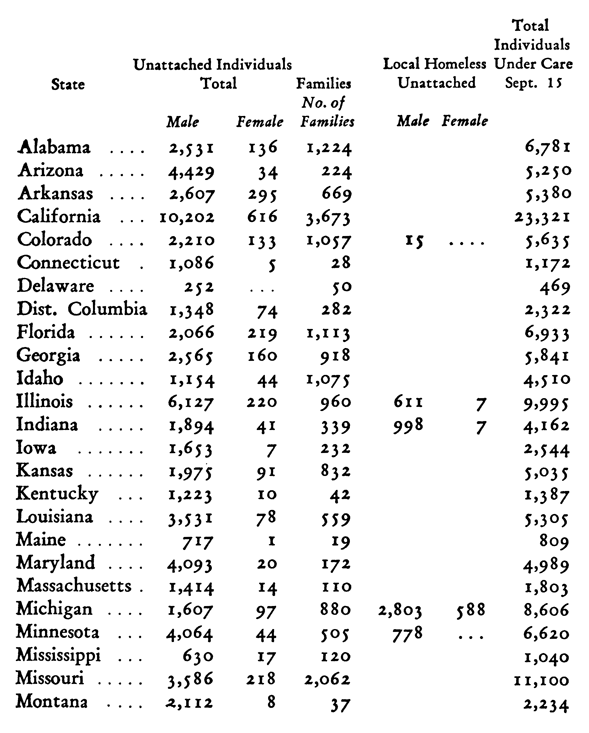
WHAT MAKES SISTERS OF THE ROAD?
WHILE working for Andrew Nelson, I gathered and kept, for a book which we were to do together, a great many statistics on the causes of vagrancy in women. The book has not yet been finished, but so much of the material already available for it is pertinent to my own story of sisters of the road, that I have brought a part of it together to include here, with his permission.
The primary factor in the production of vagrants and social outcasts is economic. To be sure, health is a factor.
Many women on the road are sick and diseased. But if they had plenty of money, they wouldn’t be on the road. They would be going to the spas of Europe and Hot Springs.
Drink also is listed among the causes of vagrancy. But the rich and the middle class drink much more than the poor women, and they never have to go on the road or apply for charity, no matter how drunk and disorderly they are.
There is really not much more difference between those who become vagrants and others. The upper classes have all the vices of the sisters of the road, and perhaps more, but no matter how lewd, vulgar, promiscuous or immoral they are, they never get on the road or become public charges, and are seldom disgraced.
About five percent of the women of the road are afflicted with psychoses and insanity. But the “Well Offs” have as many mental cases. They are sent to private institutions to be taken care of. They do not burden the taxpayers, and the public never knows of them.
Dromomania, the abnormal desire to travel, is in all classes of people. Women who have money become globe-trotters, and are continually on the go. Poor female wanderers become hoboes, because they have no money.
All other factors can ultimately be traced to environment.
SECONDARY FACTORS THAT MAKE WOMEN TAKE TO THE ROAD
(a) AGE
(1) The adolescent—the awakening of sex, and the desire to travel.
(2) The aged—the senile.
(b) ILL HEALTH
(1) Infectious diseases such as tuberculosis, syphilis, amoebic dysentery, malaria, gonorrhea and tubo-ovarian infections.
(2) Constitutional diseases—heart, kidney, liver, diabetes, respiratory, dropsy, asthma, cirrhosis of the liver, etc.
(3) Emaciation, wasting diseases—starvation, general weaknesses.
(4) Handicaps—blindness, deafness, dumbness, crippled, injuries, paralysis, etc.
(5) Glandular disturbances—hypo and hyper thyroid; Addison’s Disease.
(6) Insanity and psychoses.
(a) The hysterical.
(b) The neurasthenic.
(c) Flights and fugues.
(d) Dromomania.
(e) Melancholia depression.
(f) Dementia praecox.
(g) Epilepsy.
(h) Alcoholic insanity.
(i) Childbirth insanity.
(j) Illusions, delusions and hallucinations, that constitute misconstrued grievances and persecutions. Running away from supposed enemies.
(c) THE EXTERNAL APPEARANCE.
(The Ugly Duckling—Deformities and Lack of Physical Attraction)
(1) Consciousness of lack of attraction and beauty.
(2) Deformities, handicaps and injuries.
(3) Extremes of leanness or stoutness.
(4) Extremes of shortness or tallness.
(5) Extreme awkwardness—“Miss Gawky.”
(6) Cross-eyes and eye lesions.
(7) Hyper-trichosis (excessive growth of hair), and Hypo-trichosis (slight growth of hair).
(8) The tiny and the massive breast.
(9) A natural appearance of being unkempt, tough and unpleasant.
(d) VICES.
(1) The Drink Habit—the habitual, periodical and the occasional drinker whose addiction to and love for drink cannot be controlled by will or reason. The woman who drinks in spite of her determination not to drink.
(2) The Dope Habit—women who are addicted to the use of morphine, heroin and cocaine—about ten percent, mostly in the criminal group. There are a large number of marajuana smokers, but these are not dope fiends.
(3) Addiction to Gambling—women who are possessed with the idea that they must bet every cent they get on cards, horses, dice, etc.
(4) Sex irregularities—the nymphomaniacs, the masturbators, those who run away to have an abortion; well-marked homosexualists, perverts.
(e) FAILURE TO “FIT IN”—WOMEN WITH A NON-COOPERATIVE SPIRIT.
(1) Inability to get along with family or relatives.
(2) Feeling of pride which forbids taking help from family or friends.
(3) General inability to become adjusted.
(f) PREFERENCE FOR THE ROAD AND A HOMELESS, AIMLESS LIFE.
(1) Many women feel more at home in a box car and on the road than anywhere else.
(2) Others prefer cheap lodging houses and third-class hotels to their homes.
(3) Many women prefer to live in Shelter Houses and Transient Bureaus. They like to be taken care of, and don’t like to take the chance of going hungry, sleeping out or hoboing.
(4) There are some women on the road, and in Transient Bureaus because they say “What else can I do? Where can I go or hide?” They can think of no other place to live or method of existing.
OTHER FACTORS AS TO WHY WOMEN WANDER
(a) To escape from reality, to get away from poverty, misery and unpleasant surroundings.
(b) To seek freedom from parental and family discipline.
(c) To run away from husbands, lovers and admirers.
(d) Inability to find expression at home.
(e) Religion—the Search for God.
(f) To get new and better clothes. Silk stockings! Oh, what tragedies have taken place for thy sake!
(g) Climate and weather—the monotony of Nature.
(h) Hatred of farm, burg or city.
(i) Freedom and adventure.
(j) Romance—to find lovers and a husband.
(k) To get experience.
(l) “A place in the sun.”
(m) To see family and relatives.
(n) “The push and the pull.” Some drive compelling them to go away, and some call beckoning and seducing them.
WHAT STAMPS WOMEN SISTERS OF THE ROAD?
(a) The Law.
(b) The Church.
(c) Public Opinion, Custom and Mores.
(d) The women themselves, those who choose to be known as Sisters of the Road.
FOUR MAIN GROUPS OF SISTERS OF THE ROAD
(a) The economic or unemployed.
(b) The anti-social or criminal.
(c) The over sex-conscious group.
(d) The rebels.
HAZARDS OF A WOMAN ON THE ROAD
(a) Disease, injury and pregnancy.
(b) Developing into a thief, prostitute and beggar.
(c) Developing the “get-by” philosophy; thinking the world owes her a living; learning that the public will support her by charity or crime.
(d) Becoming tough and hardboiled and caring nothing for home, family, children or the good life.
(e) Finally—developing into an enemy of society and the government.
GROUP CLASSIFICATIONS OF OCCUPATIONS OF WANDERING WOMEN. LEGITIMATE
a. THE ECONOMIC GROUP.
1. Member of poverty-stricken family.
2. Unemployed woman.
3. Woman on relief.
4. Searcher for work.
5. Desire to better condition.
6. The never-had-a-job.
b. THE UNTRAINED WORKER.
1. Servant girl.
2. Agricultural worker.
3. Factory worker.
4. Housewife whose home has been broken up.
5. The nursemaid.
c. THE TRAINED WORKER.
1. Saleswoman.
2. Stenographer and clerical worker.
3. Professional and semi-professional woman.
4. Research worker.
5. Waitress.
d. THE PROFESSIONAL GROUP.
1. Actress.
2. Musician.
3. Artist.
4. Dancer.
5. Teacher.
6. Traveling student.
e. THE RADICAL GROUP.
1. The traveling propagandist.
2. The migratory radical worker.
3. The fighter. (Those who travel to strikes and free-speech fights.)
THE ANTI-SOCIALS. ILLEGITIMATE
a. VICE GROUP.
1. The amateur—anything to get by.
2. The prostitute—working en route.
3. Migratory hustler.
4. The worker in the joint.
5. The prostitute with a pimp.
b. TAVERN HABITUE.
1. The booze-hound.
2. The jack-roller.
3. The barmaid.
4. The good fellow—the saloon loafer.
5. The percentage girl.
6. The battle ax—the female burn.
c. THE DRUG ADDICT.
1. The pipe smoker.
2. The morphine, heroin user.
3. The cocaine sniffer.
4. The marajuana smoker.
HOW PENNILESS WOMEN CAN EARN FOOD AND SHELTER
1. Work in restaurants and hotels in exchange for food.
2. Work in homes and hotels in exchange for board and lodging.
3. Work in store or factory; obtain advance at end of day.
4. Get job, then get credit at hotel or boarding house, or restaurant and arrange to settle on pay-day.
5. Leave watch, jewelry, clothes as security for board.
HOW PENNILESS WOMEN USE THEIR SEX TO OBTAIN FOOD, SHELTER AND CLOTHES
1. By flirtations.
2. By promising men favors.
3. By intimacies.
4. By prostitution.
5. By homosexual relations.
CRIMINAL METHODS THAT WOMEN USE IN OBTAINING NECESSITIES
1. Stealing and confidence games.
THE KIND OF HOMES FEMALES ON THE ROAD COME FROM, IN ORDER OF THEIR IMPORTANCE
a. Broken homes, mother or father dead, divorced or absent.
b. Orphan homes, graduates from juvenile jails and institutions, poor houses and adoption homes.
c. Poverty-stricken homes, ex-prisoners and paroled, some feebleminded and insane institutions.
d. Lamsters—runaways from penal institutions, or own home, or other institutions.
HOW WOMEN TRAVEL WITHOUT MONEY
a. Walk.
b. Hitch-hike.
c. “hobo”—Steal rides on passenger and freight trains.
d. Travel in their own or friend’s automobile.
e. Motorcycle and bicycle.
f. In trailers.
WHERE WOMEN GET FREE FOOD, SHELTER AND CLOTHES AGENCIES
a. Federal, State and Municipal Relief Stations.
b. Religious charities:
Y. W. C. A.
Salvation Army
Rescue Missions
Protestant, Catholic and Jewish organizations
c. Private charities:
Travelers Aid
Working Girls’ Homes
Endowed Homes
d. Organizations:
Labor Unions
Clubs
Fraternities
Organizations they or their families belong to
e. Radical organizations.
f. Obtain credit here and there.
g. Beg.
h. Steal.
i. Pick up food and garbage from street and ash cans.
j. Sleep in alleys and box cars.
k. Starve and “Carry the Banner.”
FEDERAL EMERGENCY RELIEF ADMINISTRATION, FEDERAL TRANSIENT BUREAU, CENSUS OF TRANSIENTS UNDER CARE BY STATES

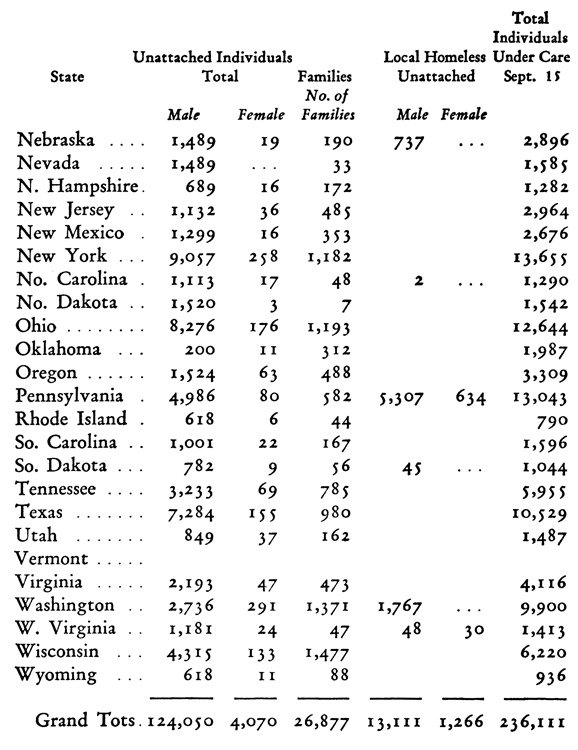
(1) ANALYSIS OF NEWLY REGISTERED UNATTACHED FEMALE TRANSIENTS
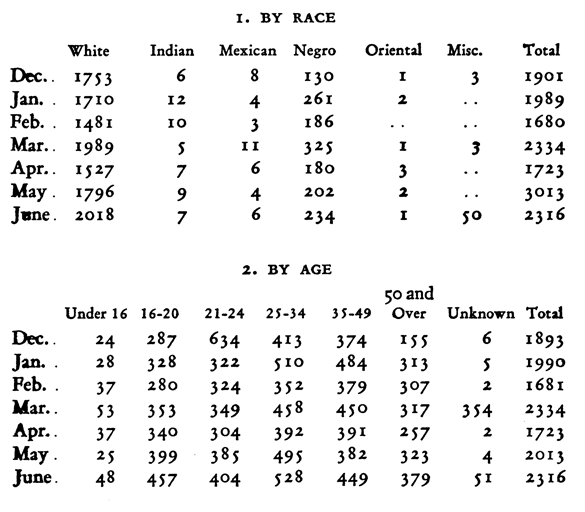
(2) REPORT OF THE TEMPORARY SHELTER OF HOMELESS WOMEN IN NEW YORK CITY
Number of Registrations:
The total number of new registrations at Central Registration Bureau in April was 149 as compared with 239 in March. The number of people accepted directly at agencies during April was 796 as compared with 826 in March.
Disposition of Cases:
The disposition of cases is as follows: (All percentages are based on total of new and old cases.)
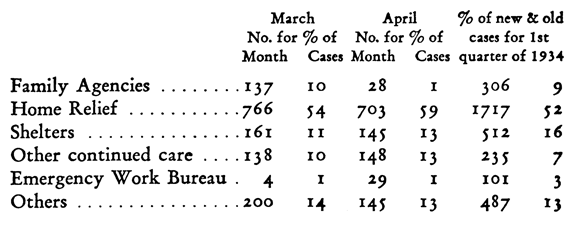
Includes hospitals, food stations, and various agencies not giving continued care, and those people who have been able to manage with advice only.
The total number of women accepted for any kind of continued care in March was 1041 or 74% of the total, in April was 879 or 73% of the total.
Social Statistics:
In March there were 143 women under 25 years of age, representing 12% of the total for the month; in April there were 114 representing 11% of the total for the month. This shows a decrease of 1% in the number of younger women.
A study of the living arrangement of the women reveals that in March 479 or 42% of the total groups were living in furnished rooms; in April 386 or 37% were living in furnished rooms. 90 or 8% of the March group were living in shelters at the time of registration; 60 or 6% in April were living in shelters. Of the remaining 57%, 247 have been living in their own apartments, 129 were living with relatives or friends.
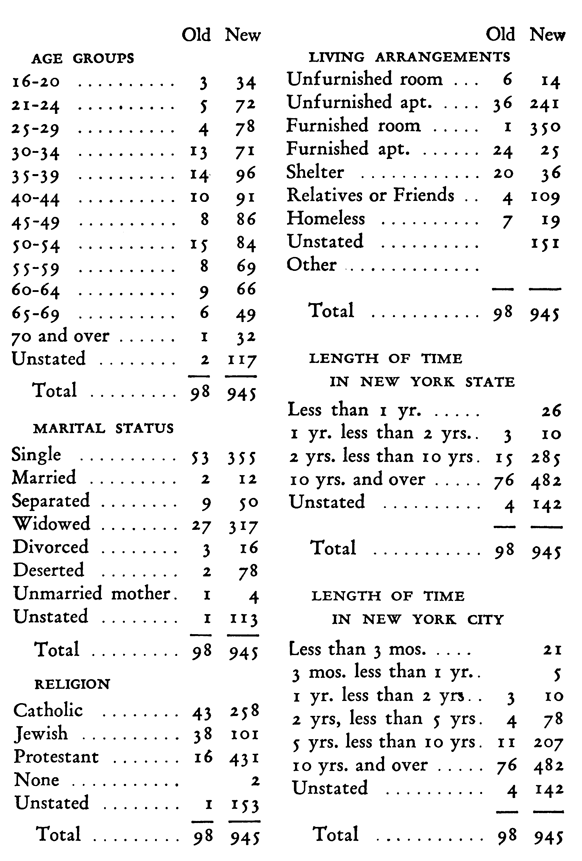
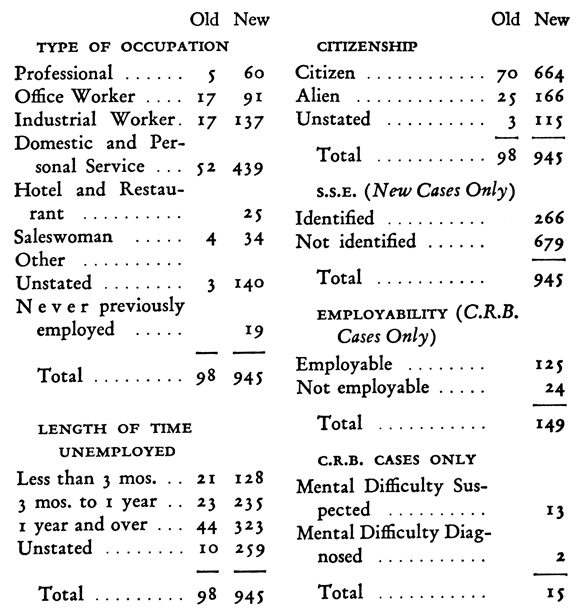
(3) REPORT ON TRANSIENT AND HOMELESS WOMEN IN PENNSYLVANIA
Pennsylvania plays host to approximately 600,000 people yearly, who find it necessary to ask for food and lodging for which they cannot pay.
Experience has shown that the transient population corresponds in character and content with the resident group. It includes men and boys, women and girls and families.
Philadelphia and Pittsburgh furnish the largest number of problem men and women. The transient age group are:
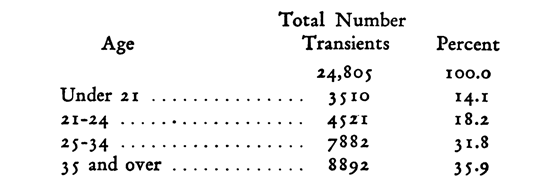
We have found that 80% of the Pennsylvania transients are white, and 20% are Negroes, and about 15% are foreign-born. As to the Marital Status 90% say they are married, and 10% single.
The transient group appear to be more venturesome and intellectually superior to the resident homeless.
No comparable or definite information is available regarding the transient movement for women and families. Recent studies indicate a surprising growth in the number of women and girls on the road necessitating a more constructive consciousness of their problem. It is reasonable to expect that large numbers of them will react to the conditions which men encountered as the original swoop of declining employment overtook them. Families offer a more perplexing problem.
CLASSIFICATION OF SPECIAL CHARACTERISTICS OF VAGRANTS AND SISTERS OF THE ROAD
Each of the types of the Social Outcast have distinct and definite characteristics which stamp them as belonging to their class.
Ordinary Vagrants CriminalSisters of the Road
1. HEREDITY

2. RESOURCES

3. ECONOMIC ATTITUDES

4. INDUSTRY
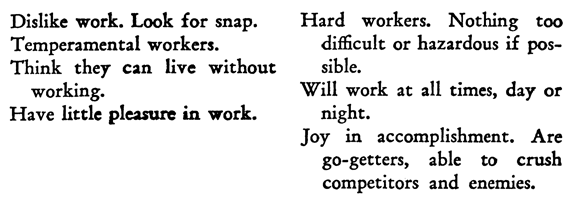
5. ADJUSTABILITY

6. INHIBITIONS

7. CO-OPERATION

8. HEALTH
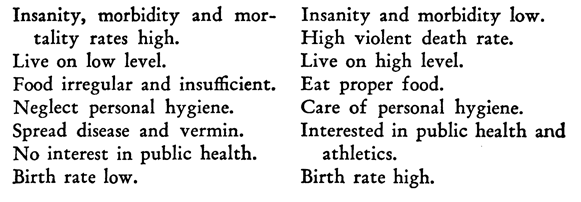
9. ENEMIES

10. RELIGION AND IDEALS

If any group is to survive, they must have survival qualities, and the fact is that many of the well-known criminals of the gangster type are dead or in jail. It is self-evident they are not successful or their successes did not last very long. “The way of the transgressor” may not be very hard, but the life of the average gangster in the limelight is short. Every modern gang is made up with one or more women. Often one-half of the mob are women.
SOCIOLOGICAL CLASSIFICATION OF WOMEN BEGGARS
Vagrancy, poverty, unemployment, charity, relief, missions, desertions, illegitimacy, have always more or less been associated with beggars. The history of the poor is the history of beggars.
Formerly when a women was homeless, penniless and friendless she existed by begging. And until recently most individuals who applied for relief felt they were beggars and were considered by a large part of the populace as being such. In so many cases the woman states that she felt humiliated; like a beggar when she first came to the Women’s Service Bureau to apply for help.
A beggar, “panhandler” or “moocher” is one who solicits food, money, clothing and shelter from individuals or institutions and gives nothing in return. She is one who thinks that society should support her. Here is a list of the most common types:
a. Panhandlers: those who beg money on the street. “Mister please give me a dime.”
b. Moochers: those who ask for food in stores or back doors.
c. Peddling Panhandlers: those who offer for sale papers, pencils, etc., not with the thought of selling them, but as a stall to beg money.
d. The old clothes moocher: one who begs clothes and sells them.
e. The Panhandling Con: the woman who begs for an organization, saying it is for charity or some good cause, and then pockets all of the money.
f. The Panhandling Mother: the woman with a baby in her arms or one or two children by her side. Sometimes these panhandling mothers call attention to the fact that they are pregnant.
g. The Chiseling Panhandler: the woman who begs from her friends and acquaintances; who goes to a meeting, lodge or church and tells a hard-luck story; never begs outright, but by innuendo. The hitch-hiker is a notorious chiseler who tells the person who gave her a ride that she hasn’t eaten for days. They have all kinds of pathetic sob stories.
Beggars are divided into many types. The woman on the road usually begs for food, but often asks for money. Her begging is a natural outgrowth of the peculiar get-by philosophy that has developed amongst most beggars.
They may be further sub-divided into groups:
a. Blinkey (blind)
b. Deafey (deaf)
c. Dummy (dumb)
d. D. & D. (deaf and dumb)
e. Army or wingey (armless)
f. Peggy (legless)
g. Crippy (paralyzed)
h. Fritzy (epileptic)
i. Nuts (feeble-minded or insane)
j. Shaky (with pronounced tremors)
The above groups are true types of handicapped women. There is also a group of professional beggars who are phoney or pseudo-handicapped. They imitate practically every type listed above and some are so able to imitate a blind, deaf or crippled person so well that only an expert can detect them. The most common types of pseudo-handicap beggars are:
1. BLISTERS. (Those who put acids or alkalis on the limbs to create the impression of ugly sores.)
2. TOSSOUTS. (Those who distort and throw joints out of order. Many are experts at this.)
3. HIDDEN HANDS. (Those who hide and bind hands.)
4. FLOPPERS. (Those who sit or flop down in front of a church or building and give the impression of being cripples.)
5. GHOSTS. (Those who simulate pallor, haggardness, or coughing to imitate a tubercular patient.)
The professional beggars have devised hundreds of ways of deceiving the public. The woman beggar and the sister of the road is not necessarily identical, but the woman who is broke part of the time is apt to become the woman who is broke most of the time and gradually acquires a technique of supplying her intimate needs. The casual vagrant woman that Jives from day to day, getting just enough to see herself through the day, is a potential beggar. Practically all of the women of the road say they do not get enough to eat, or enough clothes, and they see no reason why they should not beg. Comparatively very few women survive a prolonged stay on the road, without becoming some type of a beggar.
HOW WOMEN HOBOES BEG
1. Stimulate Pity—by whining, apologizing, emphasizing their hunger, disease or distress.
2. Stimulate Sympathy—by telling hard-luck stories.
3. Stimulate a sense of Comradeship—by appealing to a fellow-worker, union member, lodge sister, member of an organization, church, etc.
4. Chisel—by edging in on gamblers or racketeers—being with friends when they are paid off—by horning in here and there.
5. Stimulate Fear—by meeting a woman who is alone and frightening her, by insinuating they must have help—going to a back door when the woman is alone and demanding food.
6. Work Confidence Games—by requesting a loan and promising to return it—by flashing a telegram saying that they are going to get money—stating they are related to someone whom the person knows.
CHISELERS, CHEATERS, BEATERS AND CREDIT SEEKERS
The women of the road have comparatively little difficulty in “getting by,” any more than the average woman elsewhere has. Just as the father and the husband and the family have provided down through the ages, there are those who provide for sisters of the road.
It has been comparatively recent that women have been obliged to shift for themselves, to vote for themselves, to make their own paths in life, and naturally when women leave home and think and do for themselves, they choose the easiest way—and the easiest way may be the crookedest way. Whether the women are instinctively liars and cheats and crooks, has yet to be proved or disproved.
Whether for selfish, sexual, or other reasons man enjoys coming to the rescue of a woman in distress, it permits him to be gallant, to be strong, to rescue the weak. Many men who would let another man starve to death will give all they have to some woman in a panic of real or simulated distress.
The three things that penniless women do beside starve are work, beg, and steal, but we must add another method whereby women can easily get money, food, shelter, and clothes, without working, begging, stealing or selling their bodies. Various names are given to those who follow this method of getting assistance.
1. Chiselers.
2. Cheaters.
3. Beaters.
4. Credit Seekers.
These might be listed under the term of racketeers or confidence women—the so-called “Cons.” But modern hoboing has developed so many new angles that it may aid in understanding to define these terms.
1. THE CHISELERS.
A chiseler neither begs, borrows, nor steals; she just horns in, tells a pathetic story of want and distress in such a way that the hearer feels guilty or uncomfortable if he doesn’t come to the rescue. She never directly asks for anything and claims friendship with the individual she chisels.
“How do you do, Mr. Smith,” she says. “I’m Miss Jones. I just came from the University of Ohio. I knew your daughter, Priscilla, and we were such good friends. She’s such a wonderful girl, and, and, and…. I’m just so embarrassed; I expected a check at the post office and it didn’t come.”
Or she tries another tack.
“I’m so glad to meet you. Father is a thirty-second degree mason and I see you’re a mason also. I’m in a terrible predicament. I live over at the Palmer House and I want to move. It’s so expensive over there; but I owe a little bill of twenty-two dollars. I expect dad in town next week and he’ll scold me for being so extravagant.”
The favorite method of the chiselers is to be in a gambling room and to horn in with the winners; to be with some acquaintances when they get paid. There are many other methods.
2. THE CHEATERS.
A cheater is one who misrepresents herself, who lies and deceives and makes false promises in order to obtain money, food or shelter. “My name is Sadie Bolliver, I live at 2742 Grand Avenue. My father is the foreman at Sears Roebuck.”
3. THE BEATERS.
A beater brazenly obtains credit in her own name and gives the impression that she is responsible and will pay the bill. A woman registers at a hotel and at the end of the week “beats it out.” At stores she says: “Send me a statement at the end of the month and I’ll send you a check. I always deal this way.”
4. THE CREDIT SEEKERS—THE BORROWERS.
This group cannot be called properly, crooks, racketeers or confidence women. They seek to obtain credit, they ask for loans or they ask for credit in stores, hotels or restaurants and honestly intend to pay their debts. They must be clearly differentiated from the dead beats, or confidence women, who have not the slightest intention of paying, they honestly intend to pay their bills and it is surprising how easy it is for a woman on the road, homeless and penniless to obtain credit. Most any woman, fairly-well dressed, with a little baggage can go to a hotel and register and say: “I’m expecting a check in a few days,” or to a rooming house and say: “I’m sorry but I haven’t any money now but I expect to get a job. I can pay you in a week,” or “I expect a letter from home with a money order.”
There are very few restaurants who will turn down a woman who will say, “I’m sorry but I haven’t any money and I’m hungry. If you’ll give me my dinner I’ll pay you later.” The merchants, especially the small merchants, do not hesitate to take a chance in giving a woman a pair of stockings, or a pair of shoes, or a cheap dress, on credit. It’s absolutely amazing how women can live on credit.
A number of women among my friends have gone into banks, total strangers with absolutely no security, and have been able to secure loans of ten, twenty or fifty dollars. There are some women, as well as men, that you simply can’t turn down when they ask for credit. Women who belong to labor unions, organizations, churches, find it very easy to borrow money.
If a woman has a domicile other than a shelter house or relief station, she has comparatively little trouble in opening up an account at the neighborhood shops and large department stores. A small payment down enables one to furnish her house with radio, piano and even an automobile. It is true, “Ask and you shall receive.”
SOCIOLOGICAL CLASSIFICATION OF THE CRIMINAL OR ANTI-SOCIAL GROUP OF WOMEN
A small percent of the “Sisters of the Road” are active criminals or grafters. Most of the girls who fall into the hands of the law are arrested for vagrancy, disorderly conduct, or drunkenness.
There are very few women of the road who are full-time professional thieves or crooks. The criminal Sisters of the Road fall into the following types:
1. PETTY LARCENY THIEF.
The girl who steals food from grocery stores, fruit from fruit stands, clothes from lines, automobile accessories from automobiles, the mat from a door, umbrella from a stand, etc. She will steal anything that is easy to steal and where she thinks she is not taking much of a chance. There are three types of these women:
a. Professional—the girl who makes a practice of and who makes a living from stealing.
b. Amateur—the girl who steals occasionally, who has no intention of continuing to steal.
c. Accidental or Hungry Thief—the girl who steals food because she is hungry—a small article to sell in order to obtain a night’s lodging—who steals clothes because she needs them. She only steals in desperation.
2. SHOP-LIFTER, BOOSTER, DERRICK OR CLOUT.
The girl who steals things from stores. The professional shoplifter makes a practice of stealing from department stores; the sisters of the road who practice shop-lifting confine themselves to second-hand stores, junk shops, neighborhood stores. They are not very clever and most of them are amateurs. If a girl is a good thief, she can steal enough to live well and pay her way.
3. THE JACK-ROLLER.
One who robs or “rolls” a drunken person. From time immemorial the drunk always spent or lost money, and it is a theory that you do a drunk a favor if you take his or her money away. This is the way to keep him or her sober. Sailors, miners and lumber-jacks and even skilled union men and women, when drunk, are very often robbed. Many women who are apparently honest and decent and would never think of stealing anything, appear to have no compunction about robbing a drunk and it is usually true of sisters of the road. Nearly every drunk locked up in a police station with money, wakes up robbed, so jack-rolling is part of the life of a drunkard.
4. THE STRONG-ARM ROBBER
Strong-armed robbery is probably the most common kind of robbery that occurs among female hoboes. The technique is very simple. No firearms are required and hence the danger of a charge of robbery with a gun is not incurred. The robber, in strong-arming a victim grips the victim’s neck and chokes him. As she is doing that, she has at least one accomplice—usually two—who go through the pockets of the victim and punch him either in the abdomen or in the head and knock him down and run. In a crew of strong-arm robbers there is often a woman. She lures the victim into an alley or hallway.
5. BURGLARS.
Burglary is rather rare for a woman, but sometimes women break into empty buildings, steal plumbing, etc., or into a home and steal furniture or jewelry. Quite often they break into a bootleg joint or liquor store in order to steal liquor. Often they “crash” (break into a store window).
6. HOLD-UP OR “HOIST” WITH A GUN.
The woman who uses a gun for robbery is very uncommon, but a number of females have been arrested for this crime.
7. HUSTLING OR SELLING OF FAKE OR STOLEN GOODS.
Slum hustling—Selling fake jewelry.
Weave hustling—Selling spurious cloth.
Skin hustling—Selling fake fur.
Worm hustling—Selling fake silk.
One can “hustle” almost anything that is crooked, and many sisters of the road hustle one thing or another.
8. PICKPOCKETS, CANNONS, WHIZZES OR GUNS.
There are many professional and amateur pickpockets who work the road.
a. Moll-buzzers: Women who specialize in robbing the pockets or purses of other women. Many sisters of the road belong to this class.
9. CONFIDENCE WOMEN.
Many women have been the victims of confidence women and not a few sisters of the road practice the confidence game. The most common type seen around the roads is that in which a confidence woman says to a female hobo, “For two dollars I’ll get you a job,” or “For three dollars I know where you can buy a new dress.” There are many angles to this game, and women of the road are easily duped.
Types of “Cons”:
a. Solicitors for fake magazines (sheet writers).
b. Solicitors for fake charities, etc.
c. The carnival workers.
d. Pitch women.
10. SHORT CHANGE ARTIST OR HYPE.
There are various methods by which a woman tries to confuse or frighten or cheat others in making change.
11. THE GAMBLER CROOKED GAMBLER.
The most common is the “duke player,” the person who cheats at cards or checkers. Women on the road gamble considerably and there are not a few sisters of the road who try to cheat the other women. Another common trick of crooked gambling on the road is the “match” or the “smack,” in which three women match pennies or nickels and often two of them will cheat the other woman.
12. THE CHARLATAN.
A charlatan quack is a real, or phoney professional woman, sruch as a bona fide doctor, lawyer or educator, who uses her real or supposed knowledge to fool or bluff the public, in order to exploit her clients.
13. THE FAKER.
Fakers include the street corner or doorway “pitch women” eulogizing their corn cure, razor blades, Indian herb tonic, etc. All games and concessions at the carnivals, fairs, bazaars, etc., come under this heading.
These forms of modified larceny are not condemned as they provide more amusement than harm. The average person attends these affairs for the sole purpose of being “taken.” If after spending a dime at each of the attractions he arrives home with some money, he feels that he did not fully enjoy himself. There is, however, a vicious gambling element connected with some touring carnivals which is very expensive and harmful.
CLASSIFICATION OF SISTERS OF THE ROAD, AMOUNT OF MONEY REQUIRED FOR THEIR MAINTENANCE, ACCORDING TO THEIR NEEDS
Necessity, the mother of invention, is also the mother of many types of social outcasts, and quite often the amount of harm the outcast does to society iS in direct proportion to her unsatisfied needs.
A vagrant who depends upon the charities or the missions or a few dimes that she begs on the street for her bed and board does little harm.
A bum who is addicted to drink and is satisfied with cheap moonshine or “canned heat” can keep soused for about a dollar a day. This she obtains by begging and petty larceny. She injures society little.
A drug addict needs from three to ten dollars a day, and if she is a shop-lifter, would have to steal at least thirty dollars’ worth daily, for a “fence” could give her only about a third of the actual value of the articles. A dope fiend must have her dope and will stop at nothing to obtain it.
A high-class grifter living on the Gold Coast, keeping a couple of new cars, with a cabaret habit and supporting a bunch of hangers-on, would need a thousand dollars a week.
CLASSIFICATION III
CLASSIFICATION OF WOMEN HOfeOES WHO ARE RADICALS, REVOLUTIONISTS, REBELS, AND DISCONTENTS; THESE ARE COMMONLY KNOWN AS REDS
A large number of the girls on the road live in an environment where radical propaganda is most common. Many of the women have belonged to various labor organizations, I. W. W., Socialist Parties, Communist Party, and anarchist groups. The most common organizations and groups that the women have belonged to are:
RADICAL ORGANIZATIONS
1. The I. W. W.—the Industrial Workers of the World.
2. Socialists—Socialist Labor Party.
3. Communists—Communist Party—the Trotskyites—the Left Wingers. There are several different parties, but the large and most important are the Communist Internationales or the Bolshevists.
4. Anarchists—Anarchist Communists of the Emma Goldman, Alexander Berkman, Peter Kropotkin types. Individualist anarchists of the Max Stierner, Tucker, and Frederick Nietzsche types.
5. The Single Taxers.
6. Hobo Organizations—International Sisterhood Welfare Association—I. S. W. A.—The Down-and-Outers—The Zeros managed by Urban Ladue—The Hobo Colleges.
7. The Itinerant Workers Union—The Hoboes of America.
8. Unemployed Councils.
a. Unemployed councils—Communists.
b. Committee of the unemployed—Socialists.
c. The unemployed committee—I. W. W.
d. The unemployed committee—A. F. of L.
e. Unemployed groups of many other kinds.
9. The League for Industrial Democracy—Socialists.
10. The International Labor Defense—Communists.
11. The General Defense Committee—I. W. W.
12. The Technocrats.
13. Special organizations such as The Plebeian Forum—The Worker’s Forum—The Vagabond Club—The Bug Club—The Dill Pickles—The Direct Actionists—The Kill the Rich—The Secret Thirteen, etc.
All the above organizations and groups can be divided under four general headings, depending on their purposes and aims and tactics and methods of action. It is the primary purpose of all these groups to do away with poverty, to abolish unemployment and to better the conditions of the workers. Some of these organizations have as their chief object the abolition of the capitalistic system—the profit system.
CLASSIFICATION OF RADICALS ACCORDING TO THE TACTICS THEY ADVOCATE
1. Those who advocate education, organization.
2. Those who advocate political action.
3. Those who advocate mass action—strikes—Hunger marches—demonstrations—make demands upon the government for benefits such as old age and unemployed insurance.
4. Those who advocate revolution, violence, appropriation, confiscation—the taking over of the warehouses, the mills, the mines, the factories—those who would kill the rich and the tyrants and bomb anyone who stands in the way of the workers getting the full product of their labor—those who are willing to use every method to destroy their supposed enemies and put their class in power.
CLASSIFICATION OF TYPES OF RADICALS
1. The professional agitator—the soap-boxer—the propagandist who spends most of her time trying to win converts. She may be on a small salary but most of the time is unpaid.
2. The peddler of radical literature—she sells the official papers of the organization—distributes pamphlets—pastes up leaflets on shelter houses and telegraph poles. She usually gets a commission on selling literature.
3. The active member—the active worker—the woman who takes her organizaton seriously and attends meetings regularly—tries to win converts and her ideals are her religion.
4. The sympathizer—the one who is sympathetic towards radicalism, but is not especially active, will go to meetings, give in the collection, but will not join a demonstration or say very much about what she believes.
5. The indifferent—She has a slight interest in radicalism but no particular admiration for it. If she thought they would win she would go with them, but she is just as willing to join the Democrats.
__________
Down through the centuries, the vagrant, the wanderer, the homeless, unattached woman has been associated with drunkenness. Vagrants and mendicants are usually thought of in terms of alcoholics.
The theologians and a large percent of the lay population have associated vagrancy, unemployment, delinquency, and poverty with alcohol. It has been thought by many and is believed yet by not a few that alcohol is responsible for all of the unemployment, prostitutes, crime, and evil in the world.
We need to be reminded that a large percent of the women that are employed in all walks of life—saleswomen, servants, professional women, actresses, artists, drink to excess, and yet, for the most part, are able to do their day’s work. There are thousands of factory workers who get drunk and still do good work. The same can be said about newspaper women who drink a considerable portion of the time and still work well. Many of the drunkards in the shelter houses, if they were working, might drink the same amount of liquor and not be a menace. And so it is well to understand the liquor consumed is quite apt to affect a sister of the road somewhat differently than it would an employed woman.
Three Kinds of Booze Consumed by Sisters of the Road
1. Legal Liquor. 2. “Moonshine” 3. Denatured Alcohol.
The Psychic Effects of Drinking Alcohol
Last year about 5,000 supposedly mental cases passed through the Psychopathic Hospital in Chicago. About 15% were diagnosed as alcoholic. The majority of these were not committed to the insane asylum, but were discharged, apparently recovered. The records in the Chicago Hospital suggest that alcohol, whether methyl or denatured, is responsible for apparently little insanity. Alcoholism and psychoses have always been associated. Whether the psychoses is responsible for alcoholism or alcoholism is responsible for psychoses, we are not able to say at this time.
__________
SOME NEW TYPES OF SISTERS OF THE ROAD—MIGRANTS, TRANSIENTS, AND REFUGEES
Since the government has become socialized, humanized and “New Deal” there are appearing some new terms in sociological literature.
TRANSIENT. A transient is a sister of the road who applies to a government relief organization for assistance and whose residence is in another state or county.
MIGRANT. A migrant is a person who is traveling around the country seeking to make a living by honest work. These were formerly called “hoboes.”
REFUGEE. Refugees are those women who have lost their homes because of droughts, floods, and other catastrophes over which they or their family or the community have no control. The recent drought in the west and the floods in tha cast are responsible for thousands of women being on the road.